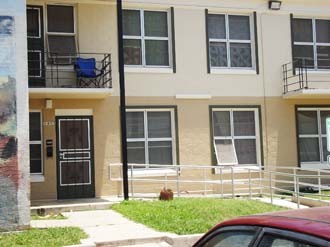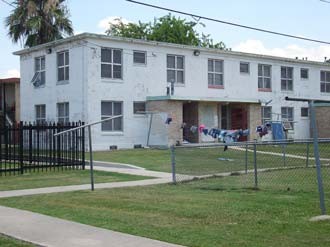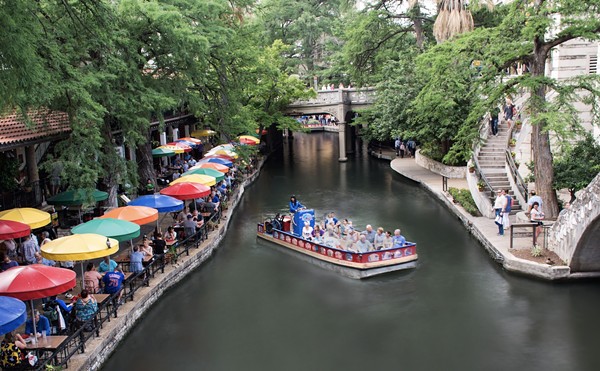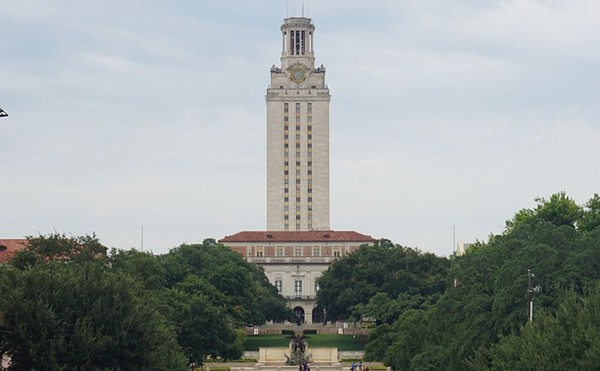SAHA renovates its public housing, signaling a philosophical change that integrates the very poor into the community
The 65-year-old apartments at Lincoln Homes, a public housing development on the West Side, are two-story, military-style cement bungalows, built in blocks that rely on paint for ornamentation. Here and there a window is outlined in faded primary colors, but the paint is peeling off the worn edifices.
Yet, there are small signs of change. One bungalow is bright white with primer, another has a fresh coat of taupe paint. Cream-colored trim decorates its mid-section and its windows are newly framed in wood that has been painted a rich shade of forest green.
| This month, the housing authority begins rehabilitation of the cinder-block bungalows. It will add wood trim to the façade and windows, breaking up the building's flat lines, and a new paint scheme of taupe, cream, and forest green. (Photos by Melissa Santos) |
Seven months ago, Henry Alvarez - less than 200 days into his new role as San Antonio Housing Authority CEO - said that by June he hoped to begin renovations on a group of public-housing communities he called the Big 6: Lincoln Homes, Alazan-Apache Courts, Cassiano Homes, Wheatley Courts, Sutton Homes, and San Juan Homes.
"When I got here a year ago, we had some pretty significant operational issues that were plaguing us," says Alvarez. "I think we've got our arms around that. Now we have some buildings that are reaching economic obsolescence."
SAHA has spent much of the last year drafting plans for the Big 6 rehabilitation. The Big 6 properties - now the Big 8 if you include High View and W.C. White - comprise 2,500 units, which SAHA estimates will take 10 years and $162 million to renovate and rebuild, money that the housing authority does not yet have. There is also a timing issue: People live in the homes, so SAHA must orchestrate its work so residents can shift into new homes without severly disrupting their lives.
A new paint scheme will briefly tide over Lincoln Homes, other public housing such is structurally unsound. "It's not what you see above ground," says Alvarez. "It's what you see below the ground that is the issue - sewage and plumbing. We have `buildings` that are stable, which we will repair, and `buildings that` need to be repositioned in total, meaning we will demolish them and start over.
| SAHA built Lincoln Homes, a 338-unit public housing community, in 1940. |
"As we attempt to do this, HUD is facing constrained resources. So We'll have to use just about every combination of financing - HOPE VI grants, partnerships, tax credits, and a little Robin Hood economics - whatever it takes to get the job done."
Refugio at Victoria Commons was partially funded by a grant from HUD's HOPE VI program. However, it took three tries to secure the grant, which funds projects to demolish and rebuild severely distressed public housing. "Those grants are drying up, it's very competitive, and they tend to go to large, urban areas," Alvarez says.
The housing authority plans to apply for other grants - it already has a $25 million grant from Fannie Mae - and will use its yearly capitol grant, the amount it receives from the federal government annually to maintain public housing, to secure loans. SAHA will also continue partnering with private developers such as Carleton Residential Construction, which worked with the housing authority on Victoria Commons, and NRP Group, which is involved in the redevelopment of San Juan Homes.
Alvarez also plans to funnel revenue from SAHA's market-rate commercial real estate back into public housing, which is why it is building projects like the Rex, a 200-unit, mixed-use, mixed-income development that will sit at the corner of Brooklyn and St. Mary's, on the northern reach of the San Antonio River.
Mixed-income housing is central to SAHA's plans for the Big 6. "In the past, we had large-scale warehousing of the poorest of the poor in public-housing communities," Alvarez says. "It was supposed to be transitional, but that's very difficult when you have people living in a community apart, with no connection to the way the rest of us are living."
|
Timeline of the Big 6 projects San Juan Homes High View Apartments Sutton Homes Wheatley Courts Cassiano Homes Lincoln Homes Alazan-Apache Courts W.C. White |
In order to do that without decreasing the number of units available to public-housing residents, some Big 6 properties will have more units after the rebuild. For example, Sutton Homes will increase from 242 units to 504 units. Yet, in schematic drawings, the new community actually looks less dense. Cul-de-sacs, playgrounds, and a community building with a swimming pool look less like traditional "projects," and more like modern suburban neighborhoods.
"The idea is not to shrink the size of the available housing, but to balance the environment with mixed-income communities," says Alvarez.
In theory, mixed housing will not only ease intolerance toward public housing by helping to raise property values in those neighborhoods but also could alleviate some issues that follow concentrations of poverty such as higher teenage pregnancy and high-school dropout rates. "Mixed income allows role modeling," explains Alvarez. "Where you have the very poor living next to those at 60 percent of the median income, they can start to see the benefits of certain jobs, to be inspired by a higher quality of life."
To create mixed-income communities, SAHA will have to spread the Big 6 residents across different housing developements, yet currently there are not enough homes to accommodate that goal, so SAHA will have to create new housing while it rehabilitates the Big 6.
Although Alvarez is reluctant to discuss details and timelines of the new housing development or individual Big 6 renovations until the funding is in place, he will say that SAHA will first rebuild communities with serious infrastructure issues, such as San Juan and High View. Properties such as Lincoln Homes and Alazan-Apache Courts, which are basically structurally sound, will receive cosmetic updates and maintenance until SAHA can rebuild them.
"Our dream is to not do it in pieces, but to keep the project moving every year," says Alvarez. Nevertheless, funding will likely push the substantial work of some of the communities into the 10-year range. "This is a career product - Henry may not be around when it is finished, but we think that in the next three years you will see a big difference." •
By Susan Pagani




















